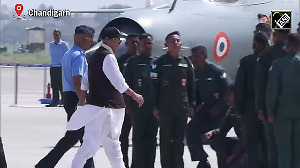Tamil civilians trapped in the fighting in northern Sri Lanka are surfacing and coming over to government-controlled areas during the last few days.
As town after town controlled by the Liberation Tigers of the Tamil Eelam fell to the offensive launched by the Sri Lankan forces in the last one year, officials had been mystified by these ghost towns with no residents.
And it was apparent that either the Tigers had taken away the local population or they had gone with them voluntarily as they took shelter in the thick jungles--their last refuge. ut now a trickle of these Tamils have started their return back home.
According to new estimates, as many as 2057 Tamil civilians have quit the LTTE areas and sought refuge with the Sri Lankan Army in the last few days and International Red Cross has rushed in more staff to Wanni region to cope up with the challenging task of rehabilitating them.
"The new situation has made it necessary for the ICRC to bring in more international and national staff to manage the convoys and communicate with the parties on the ground," said Paul Castella, the ICRC's head of delegation to the Wanni.
The number of internally displaced persons seeking refuge with the government authorities surpassed the 2,000 mark on Monday as the government reiterated that arrangements were in place to help displaced civilians.
Resettlement and Disaster Relief Services minister Rishard Bathuideen said that by yesterday, the number of IDPs who sought refuge in the cleared areas, had increased to 2,057 and they were housed at welfare centres in Vavuniya with all facilities.
Welfare centres have been organised in Menik Farm, Menik Farm II, Nelumkulama and Omanthai with the capacity to house 30,000 families, Bathuideen said.
Authorities are also preparing three villages with a single house for each family being provided, namely in Chettikulam, Omanthai and another location in Vavuniya, the state-run Daily News reported.
These villages and temporary camps would be equipped with all facilities until the families are resettled in their original villages, which would be expedited after securing those areas and building the needed infrastructure, he said.
Officials belonging to several Ministries, currently in Vavuniya, are preparing a comprehensive report on how to facilitate expediting relief measures, and the final report would be presented to the President Mahinda Rajapaksa shortly, Bathuideen said.
The displaced from uncleared areas are to be provided with cooked meals, dry rations, drinking water, health and sanitary facilities, electricity, cooking utensils, clothes, infant food and all other essential items.
A daily allowance of Rs 100 are to be given to the displaced Tamil civilians coming into the government held areas.
With the assistance of the UNICEF and the Ministry of Health, a hygienic kit to each family is to be provided and also supplementary food are to be given for the children to overcome any form of malnutrition during this time.
School going children are to be facilitated with uninterrupted education, through out their temporary stay at welfare centres with the involvement of the Education Ministry. Banking facilities too are to be provided within these centres, the newspaper reported.
"Civilians in the Wanni are weary from the conflict. Repeated displacements, often involving the loss of their personal belongings, have taken a toll on them. Nevertheless, their ability to cope has been remarkable," said Castella.
"The ICRC is committed to stay at their side as long as there are needs to address", Castella said. In addition, the ICRC has to negotiate safe passage over a distance of up to 30 kilometres between government--and LTTE-held areas.
The new situation has made it necessary for the ICRC to bring in more international and national staff to manage the convoys and communicate with the parties on the ground, the ICRC said.
The ICRC also negotiates with the parties to the conflict to arrange for the safe passage of ambulances transferring patients and health professionals back and forth between the various medical facilities in LTTE-held areas and Vavuniya.





